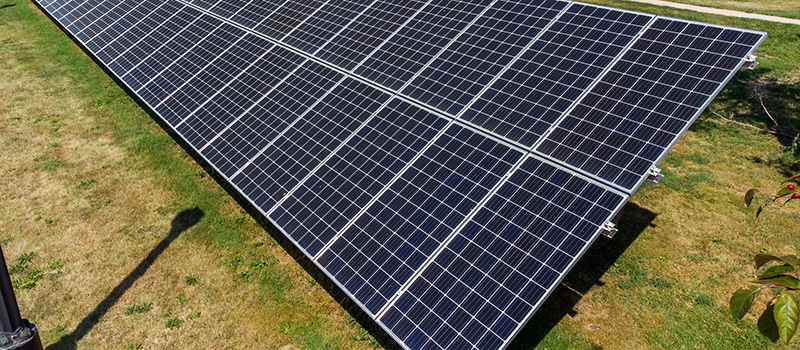Work underway on substantial solar farm near campus
August 19, 2021 — On a 30-acre field just northeast of campus, a solar farm is springing to life.
Construction is underway on the 4-megawatt solar installation, which will provide about one-third of campus electricity, offset 18 percent of campus emissions, and save the College approximately $3 million in electricity costs over 20 years.
“This solar project is a huge step toward reaching our commitment of carbon neutrality,” says Chris Bair ’96, the College’s environmental and safety coordinator, and co-chair of the Sustainability Committee. The College has a goal of becoming carbon neutral by 2040, meaning achieving a balance between the amount of emitting and absorbing carbon dioxide.
 Solar panels, like these that are located east of Main Hall, will soon be installed on a 30-acre field northeast of campus. When completed, it will be the largest privately-owned solar project in Iowa.
Solar panels, like these that are located east of Main Hall, will soon be installed on a 30-acre field northeast of campus. When completed, it will be the largest privately-owned solar project in Iowa.
The installation will consist of bifacial panels linked to a single axis tracker that will rotate the panels from east to west each day to better follow the sun. The College has signed a 20-year purchase agreement with Iowa-based Trusted Energy to provide renewable electricity from the solar installation.
The $7 million project stems from the work of the Task Force on Fossil Fuel Divestment and Climate Impact established in 2017 by the Board of Trustees. The task force’s final report concludes that “with overwhelming scientific evidence that climate change is a global threat requiring immediate responses ... Grinnell College, as a good global citizen, should take meaningful actions that directly contribute to reducing the impact of climate change.”
“Students have been encouraging the College to move toward a sustainable, carbon-free campus for several years,” says Bair, adding that the solar farm project is the biggest initiative that the College has taken on. According to the Iowa Environmental Council, it will be the largest privately-owned solar project in the state.
The solar farm will be directly linked by cable to the College’s electric power switchgear on 10th Avenue in Grinnell. The facility also will provide 540 kilowatts of energy storage. This battery storage will significantly reduce the College’s energy costs at times of peak demand for electricity.
Even the plantings on the new solar project will be sustainable. Native vegetation will be seeded in-between the solar panels and plans call for sheep or goats to graze there.
The College is also planning a solar project at Conard Environmental Research Area (CERA), where wind power currently provides 25 percent of the Environmental Education Center’s electricity via a wind turbine that was installed in 2007.
 A rendering shows where the solar panels will be placed at the Conard Environmental Research Area (CERA). Once built, all of the Environmental Education Center’s electricity will come from solar or wind power.
A rendering shows where the solar panels will be placed at the Conard Environmental Research Area (CERA). Once built, all of the Environmental Education Center’s electricity will come from solar or wind power.
“A 131kw solar project would provide the rest of the power,” Bair explains, “making the Center net zero with regards to consuming fossil fuel energy.” The installation should be up and running by next spring. It is partly funded by gifts from Karen Van Dusen ’77, Joel Spiegel ’78, and the Student Government Association.
The College has several smaller installations on campus that provide electricity consumed by the buildings they supply. Solar panels on the Grinnell College Preschool provide 6 percent of the building’s electricity, while panels on Facilities Management offices provide 18 percent of that building’s power.
Solar panels are also powering an electric car charging station and 100 percent of electricity at the Game House (1008 Park St.); panels provide 14 percent of electricity to the Old Glove Factory; and 70 percent of electricity to the Facilities Management warehouse.
— by Anne Stein ’84